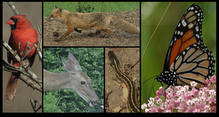Another Walk: Cardinals Always Around



Wildlife observations from a suburban backyard adjacent to the Colvin Run Mill Park in Vienna, Virginia. Click on photos to enlarge.



Posted by
Gil Miller
at
8:00 AM
0
comments
![]()
Labels: Northern Cardinal



Posted by
Gil Miller
at
5:26 PM
0
comments
![]()
Labels: Eastern Bluebird, Nests, Wren







Posted by
Gil Miller
at
8:31 PM
0
comments
![]()
Labels: Eastern Bluebird, Nests
A week ago, I took a walk in the Colvin Run Habitat (post 1, post 2, post 3, and post 4) seeking to photograph the bluebirds nesting in the bird box. A week ago, the bluebirds led me around the Habitat and proved to be elusive. Today's walk was a much different story.




Posted by
Gil Miller
at
6:26 PM
0
comments
![]()
Labels: Eastern Bluebird, Nests




Posted by
Gil Miller
at
8:15 PM
1 comments
![]()
Labels: Eastern Bluebird, Flight





Posted by
Gil Miller
at
8:12 PM
0
comments
![]()
Labels: White-throated Sparrow




Posted by
Gil Miller
at
8:08 PM
0
comments
![]()
Labels: Downy Woodpecker, Flight


>House Finch
>Carolina Wren
>American Robin
>Common Grackle
>Morning Dove
>Northern Cardinal
>Tufted titmice
>Eastern Bluebird
>Downy Woodpecker
>White-Throated Sparrow
The first photo shows the Northern cardinal (female) that is so common and numerous in the Habitat. The second photo shows the cardinal and a Carolina wren eating at the sunflower seed feeder. Note the seed in the cardinal mouth.




In the next three posts, I'll show the bluebirds, sparrows, and woodpeckers that 'played' with me as I walked the Habitat.
Posted by
Gil Miller
at
6:50 PM
0
comments
![]()
Labels: American Robin, Finches, Grackles, Mornng Dove, Northern Cardinal, Wren
amanda in the city asked in a comment last week, 'Whatever happened to the sick fox?'
After a few nights, the food was no longer eaten. Given a reading that a fox with mange seldom lives longer than 4 months and that I have not see the fox again, I assume that this fox died.
Since that time, I have found a rescue center in upstate New York offering a treatment strategy. If another fox with mange appears in the Colvin Run Habitat, I will employ the recommended strategy.
In the meantime, we await the arrival of a new fox, or two, or even a family.
The photo in this post is the signature Colvin Run Habitat fox - not the fox observed sick with mange.
Posted by
Gil Miller
at
8:29 PM
0
comments
![]()
Labels: Mange, Red-tailed Fox
These photos are for my colleague who mentioned that she noticed the goldfinches were changing colors.

Posted by
Gil Miller
at
6:00 PM
2
comments
![]()
Labels: American Goldfinch




Posted by
Gil Miller
at
2:00 PM
0
comments
![]()
Labels: Red-Bellied Woodpecker

As you can see in the photo below, I did not even need to open the box to see that a nest had been built - not the grass coming out of the box door.
Posted by
Gil Miller
at
7:12 PM
0
comments
![]()
Labels: Eastern Bluebird, Nests
Significant rain fell during the night. And sunrise yielded a never before seen animal in the Colvin Run Habitat. This never before seen animal has left me, well, speechless. Take a look at the first photo.
Yes, an American alligator right between the birth bath and the bird feeders. When the sun finally dried out the soggy lawn and the gator headed south.
LuLu paid a visit today as well. In a surprise display of courage, the little white dog from Texas took on the red tailed fox in an attempt to protect the squirrels when the fox made a charge. See the second photo.
After LuLu straightened the fox out, the two became best of buddies. See the third photo.
Oh, did I mentioned that it is April Fool's Day. Hope you enjoyed the fun!
Posted by
Gil Miller
at
9:13 PM
2
comments
![]()

This work is licensed under a Creative Commons Attribution-NonCommercial 3.0 License.
